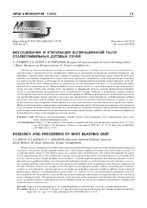Исследование и утилизация аспирационной пыли сталеплавильных дуговых печей

Date
2023Publisher
Another Title
Research and processing of shot blasting dust
Bibliographic entry
Ровин, С. Л. Исследование и утилизация аспирационной пыли сталеплавильных дуговых печей = Research and processing of shot blasting dust / С. Л. Ровин Д. И. Курач С. В. Григорьев // Литье и металлургия. – 2023. – № 1. – С. 73-78.
Abstract
Дисперсные железосодержащие отходы составляют большую часть твердых технологических отходов машиностроительных и металлургических предприятий. Проблема их утилизации по-прежнему остается открытой, что приводит к значительным экономическим потерям и создает серьезную экологическую угрозу. Около 15–20 % этих отходов составляют аспирационные пыли плавильных агрегатов. Содержание соединений различных металлов, и в первую очередь железа, в некоторых из них (например, в аспирационной пыли дуговых сталеплавильных печей) достигает 60–70 % и более. Однако сегодня, несмотря на все усилия, используется не более 5–7 % улавливаемой аспирационной пыли плавильных печей. Одной из наиболее существенных проблем ее утилизации является высокая дисперсность (размеры частиц пыли дуговых печей, как правило, не превышают 50 мкм), а также чрезвычайная неоднородность и нестабильность гранулометрического и химического состава. Поэтому в большистве случаев попытки использования этих пылей в качестве технологического продукта (добавок в формовочные и экзотермические смеси или противопригарные краски, красящего пигмента при производстве стройматериалов, модифицирующих добавок при плавке литейных сплавов, добавок при производстве цементного клинкера и др.) заканчивались на уровне экспериментальных или опытно-промышленных партий и не имели существенного значения для решения проблемы в целом. Наиболее перспективным направлением утилизации аспирационных пылей представляется рециклинг содержащихся в них металлов. В данной статье представлены результаты исследований состава и характеристик аспирационной пыли дуговых сталеплавильных печей литейных цехов машиностроительных заводов, а также условий твердофазного восстановления и извлечения содержащегося в ней железа.
Abstract in another language
Dispersed iron-containing waste makes up the majority of solid technological waste of machine-building and metallurgical enterprises. The problem of their disposal remains open, which leads to significant economic losses and creates a serious environmental threat. About 15–20 % of these wastes are assirative dusts of melting units. The content of compounds of various metals, and primarily iron, in some of them (for example, in the aspiration dust of arc steelmaking furnaces) reaches 60–70 % or more. However, today, despite all efforts, no more than 5–7 % of the captured aspiration dust of melting furnaces is used. One of the most significant problems of its disposal is the high dispersion (the size of the dust particles of arc furnaces, as a rule, does not exceed 50 microns) and the extreme heterogeneity and instability of the granulometric and chemical composition of the dust. Therefore, in most cases, attempts to use these dusts as a technological product: additives in molding and exothermic mixtures or non-stick paints, coloring pigment in the production of building materials, modifying additives in the melting of foundry alloys, additives in the production of cement clinker, etc., ended at the level of experimental or pilot batches and were not essential for solving problems in general. The most promising direction of utilization of aspiration dusts is the recycling of metals contained in them. This article presents the results of studies of the composition and characteristics of aspiration dust of arc steelmaking furnaces of foundries of machine-building plants, as well as the conditions of solid-phase reduction and extraction of iron contained in it.
View/
Collections
- № 1[26]
